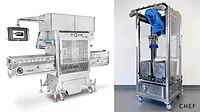New equipment lets chef prepare high-quality RTE meals

“We are going to see a tremendous amount of growth in the RTE marketplace,” says Walter Sommers, president of Ruprecht Company, a
The advanced cooking equipment available to processors today is more compact, flexible and affordable than what was available to the RTE segment in the past. Systems like the Unitherm mini flame griller, rapid flow oven and mini-spiral oven that Ruprecht purchased replaced less reliable batch cooking processes, which are harder to control and often produce meals that are inconsistent in quality and taste.
Ruprecht, which produces chicken, beef, pork, lamb and a limited selection of seafood entrées, fully cooks about 30 percent of its products. These heat-and-serve items are prepared according to either customer specifications or those of its in-house chef.
“Our chef is using the equipment to process products that meet the same expectations as you would have if you were cooking at home on a barbeque,” says Sommers.
Rather than use somewhat unpredictable batch cooking methods where equipment has few controls, Ruprecht incorporated continuous processes into its production, using Unitherm’s automated flame grills and spiral ovens to control the production of meals and ensure they are always consistent in quality.
Built-in controls for variables (e.g., temperature, time, humidity and fan speed) allow the processor to maintain very tight tolerances to improve consistency. Touch-screen controls allow the processor to alter equipment settings if the operators choose, thereby creating new recipes that are stored for future use. The controls enable processors to further develop their current products or develop new ones.
Spiral ovens let chefs achieve exactly what they want in rotisserie, baking and basting. With a spiral oven, a built-in basting effect can be incorporated. For example, as chicken spirals upward in the oven, the juice from each piece of meat falls on the one below, enhancing both color and texture. Spiral ovens enable steaming, roasting, broiling, baking and post-pasteurizing, and can be coupled with a chiller and loading systems to suit users’ needs with limited space.
Flame grills can reach very high temperatures in short periods of time. The flame temperature of the grill is much higher than that of restaurant-type grilling equipment. It can be set as high as 1,500°F, and can be throttled back to get the desired finishing effect. In addition to throughput, this equipment has much more thermal capacity than restaurant equipment-i.e., heat energy delivered to the product.
“We produce millions of pounds of fully cooked food annually,” says Sommers. “With the new continuous production equipment we’ve recently installed, we are nowhere near exceeding their capacities.”
For information, David Howard, Unitherm Food Systems, 918-367-0197; email; or visit the Unitherm website.Looking for a reprint of this article?
From high-res PDFs to custom plaques, order your copy today!






